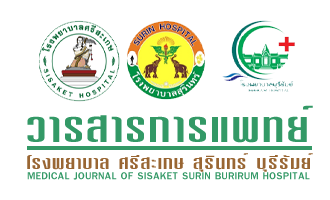ประสิทธิภาพการรักษา Patent Ductus Arteriosus ในทารกคลอดครบกำหนด ด้วยยา Indomethacin โดยบริหารยาทางปาก
Main Article Content
บทคัดย่อ
เหตุผลการวิจัย: การรักษา Patent ductus arteriosus (PDA) ด้วย indomethacin ได้ผลดีใน ทารกคลอดก่อนกำหนด มีการศึกษาและได้ใช้รักษามานาน แต่การรักษา Patent ductus arteriosus (PDA) ในทารกคลอดครบกำหนดยังไม่มีข้อสรุปแน่นอน เริ่มมีรายงานถึงการได้ผลดีของการให้ยา indomethacin เพี่อรักษา Patent ductus arteriosus ในทารกคลอดครบกำหนด
วัตถุประสงค์: เพี่อประเมินผลของการให้ยา indomethacin โดยบริหารยาทางปาก ในผู้ป่วย ทารกแรกเกิดที่เป็น Patent ductus arteriosus เพี่อเป็นข้อมูลพื้นฐานและใช้เป็น แนวทางในการปรับปรุงการรักษาผู้ป่วยกลุ่มนี้ต่อไป
สถานที่ศึกษา: โรงพยาบาลสุรินทร์
รูปแบบการวิจัย: การวิจัยเชิงพรรณนา โดยเป็นการศึกษาย้อนหลัง
วิธีการศึกษา: รวบรวมและวิเคราะห์ข้อมูลทารกที่มารักษาที่โรงพยาบาลสุรินทร์ ตั้งแต่ 1 มกราคม พ.ศ. 2552 ถึง 31 ธันวาคม พ.ศ. 2552
ผลการศึกษา: ทารกในกลุ่มศึกษา มีจำนวน 43 ราย มีอายุเท่ากับหรือมากกว่า 2 วัน และอายุ ครรภ์เท่ากับหรือมากกว่า 37 สัปดาห์ ผู้ป่วยที่ไม่นำมารักษา ได้แก่ ผู้ป่วยที่เป็น ductus-dependent congenital heart disease, pulmonary hypertension (gradient > 40 mmHg) หายใจล้มเหลว ต้องใช้เครื่องช่วยหายใจ หรือมีอาการ ติดเชื้อในกระแสเลือด ให้ยา indomethacin ขนาด 0.2mg/kg/dose ทุก 12 ชั่วโมง เป็นจำนวน 3 dose โดยการบริหารยาทางปาก พบว่า 33 ราย (76%) มีการปิดของ patent ductus arteriosus, 10 ราย (23.3%) ไม่พบมีการปิดของ patent ductus arteriosus ไม่พบความแตกต่างอย่างมีนัยสำคัญทางสถิติ ระหว่าง กลุ่มที่มีการปิดและไม่มีการปิดของ ductus arteriosus เมื่อเปรียบเทียบกับ อายุครรภ์ น้ำหนักตัวขณะให้ยา ค่า Apgar score ที่ 1 นาที ขนาดเส้นผ่า ศูนย์กลางภายในของ ductus arteriosus ก่อนให้ยา อายุผู้ป่วยก่อนให้ยา ไม่พบมีความแตกต่างในค่า urea nitrogen, creatinine, จำนวนเกร็ดเลือด ก่อนและ หลังการให้ยา ไม่มีผลแทรกซ้อนร้ายแรงในการศึกษานี้
สรุป: การใช้ยา indomethacin โดยบริหารยาทางปากได้ผลดีในการปิดของ ductus arteriosus ของทารกคลอดครบกำหนด
คำสำคัญ: Patent ductus arteriosus, oral indomethacin, Gestational age. Echocardiography, Full-term neonates
Article Details
เอกสารอ้างอิง
Mitchell SC, Korones SB, Berendes HW. Congenital heart disease in 56109 births. Incidence and natural history. Circulation 1971; 43:323-32.
Fyler DC. Patent ductus arteriosu In : Fyler DC (ed) Nadas’ Pediatric Cardiology. Hanley & Belfus : Philadelphia ; 1992 : 525-34.
Rudolph AM. The ductus arteriosus and persistent patency of the ductus arteriosus. In: Rudolph AM. (ed) Congenital diseases of the heart. 2nd ed. Armonk, Futura, NY ; 2001 : 155-96.
Clymann RI, Chan CY, Mauray F, et al. Permanent anatomic closure of ductus arteriosus in newborn baboons : the roles of postnatal constriction, hypoxia and gestation, Pediatr Res 1999 ; 45 : 19-29.
Slassi I, Ghosh P, Lubliner J. et al. Prospective analysis of one consecutively bom infant. Incidence and clinical lectures for PDA in preterms. Pediatrics 1976; 57:347-51.
Jones RW, Pickering D. Persistent ductus arteriosus complicating the respiratory distress syndrome. Arch Dis Child 1977 ; 52:274-81
Hiraishi S, Horiguchi Y, Misawa H, et al. Noninvasive Doppler echocardiographic evaluation of shunt flow dynamics of the ductus arteriosus. Circulation 1987;75: 1146-53.
Mandoria S. The ductus arteriosus in healthy newborn infants studied by continuous Doppler guided by twodimensional Doppler color echocardiography. G Ital Cardiol 1990; 20: 705-12.
Weiss H, Cooper B, Brook M, Schleuter M Clyman R. Factors determining reopening of the ductus arteriosus after successful clinical closures with indomethacin. J Pediatr 1995; 127: 466-71
Heymann MA, Rudolph AM, Silverman NH. Closure of the ductus arteriosus in premature infants by inhibition of prostaglandin synthesis. N Engl J Med 1976; 295: 530-3.
McCarthy JS, Zies LG, Gelband H. Age-dependent closure of the patent ductus arteriosus by indomethacin. Pediatrics 1978 ; 62:706-12.
McCarthy JS, Zies LG, Gelband H Age-dependent closure of the patent ductus arteriosus by indomethacin. Pediatrics 1978 ; 62:706-712.
Van Bel F, Van de Bor M, stijnen T, Baan J, Ruys JH. Cerebral blood flow velocity changes in preterm infants after a single dose of indomethacin: duration of its effect. Pediatrics 1989; 84: 802-7.
Van Bel F, Guit GL, Schipper J, Van de Bor M, Baan J. Indomethacin-induced changes in renal blood flow velocity waveform in premature infants investigated with color Doppler imaging. J Pediatr 1991; 118: 621-6.
Lai TH, Soong WJ, Hwang B. Indomethacin for the prevention of symptomatic patent ductus arteriosus in very low birth weight infants (Abstract). Zhonghua Min Guo Xiao Er Ke Yi Xue Hui Za Zhi 1990; 31: 17-23.
Van Overmeire B, Van de Broek H, Van Laer P, Weyler J, Vanhaesebrouck P. Early versus late indomethacin treatment for patent ductus arteriosus in premature infants with respiratory syndrome. J Pediatr 2001; 138: 205-11.
Lai TH, Soong WJ, Hwang B. Indomethacin for the prevention of symptomatic patent ductus arteriosus in very low birth weight infants (Abstract). Zhonghua Min Guo Xiao Er Ke Yi Xue Hui Za Zhi 1990; 31: 17-23.
McCarthy JS, Zies LG, Gelband H. Age-dependent closure of the patent ductus arteriosus by indomethacin. Pediatrics 1978; 62:706-12
Watanabe K, Tomita H, Ono Y, et al. Intravenous indomethacin therapy in infants with a patent ductus arteriosus complicating other congenital heart defects. Circ J 2003; 67:750-752
Sheng-Ling Jan et al. Prediction of ductus arteriosus closure by neonatal screening echocardiography. The International Journal of Cardiovascular Imaging 2004; 20: 255-62.
Park MK. Pediatric Cardiology for Practitioners. 4th ed. Mosby elserier ; 2008; 2002:141-44.
Takeshi T, Hitoshi Y, Tadashi K, Hideshi Y, Toshio N, Makoto N. et al. Usefulness of indomethacin for PDA in full-term infants. Pediatr Cardiol 2007; 28: 46-50.
Amooagar H. Ghodsteh M. Pishva N. Oral Ibuprofen and Ductus Arteriosus Closure in Full-Teim Neonates: A Prospective Case-Control Pediatr Cardiol 2010 ; 31: 40-3.


